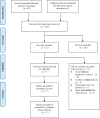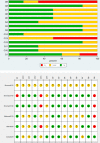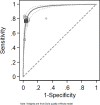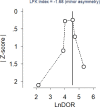Application of the Ipswich Touch Test for diabetic peripheral neuropathy screening: a systematic review and meta-analysis
- PMID: 34607858
- PMCID: PMC8491285
- DOI: 10.1136/bmjopen-2020-046966
Application of the Ipswich Touch Test for diabetic peripheral neuropathy screening: a systematic review and meta-analysis
Abstract
Objective: Diabetic peripheral neuropathy (DPN) is one of the most important risk factors of diabetic foot ulcers, and early screening and treatment of DPN are crucial. The Ipswich Touch Test (IPTT) is a new method for screening for DPN and, compared with traditional methods, is more simple to operate and requires no equipment. However, the screening accuracy of IPTT in patients with DPN has not been well characterised. We aim to conduct a systematic review and meta-analysis to characterise the sensitivity and specificity of IPTT compared with traditional methods and to understand the potential screening value of IPTT.
Design: Systematic review and meta-analysis.
Data sources: PubMed, Embase, Cochrane Library, Web of Science, China National Knowledge Infrastructure, Wanfang, Chinese Biomedical Literature Database up to 16 April 2020.
Methods: Stata V.15.1 software was used for analysis, and the screening value of IPTT in DPN was described using 10 g monofilament (10g-MF), neuropathy disability scores (NDS), Pin prick, 128 Hz tuning fork, and ankle reflex as reference standards. Sensitivity, specificity and other measures of accuracy of IPTT for screening DPN were pooled based on a quality effects model. The protocol was registered with PROSPERO (42020168420).
Results: Of the 441 records retrieved, 7 studies were evaluated for the screening value of IPTT. Five studies with 10g-MF as the reference standard were included in the meta-analysis, and the pooled sensitivity and specificity were 0.77 (95%CI 0.69-0.84) and 0.96(95%CI 0.93-0.98), respectively, and the area under curve was 0.897. Compared with vibration perception threshold, IPTT showed a sensitivity between 0.76 and 1, and a specificity between 0.90 and 0.97. Compared with NDS, IPTT showed a sensitivity between 0.53 and 1, and a specificity between 0.90 and 0.97. Compared with Pin prick, IPTT showed a sensitivity and specificity of 0.8 and 0.88, respectively. Compared with 128 Hz tuning fork, IPTT showed a sensitivity and specificity of 0.4 and 0.27, respectively. Compared with ankle reflex, IPTT had a sensitivity of 0.2 and a specificity of 0.97.
Conclusions: IPTT shows a high degree of agreement with other commonly used screening tools for DPN screening. It can be used clinically, especially in remote areas and in primary medical institutions, and by self-monitoring patients. More high-quality studies are needed to assess and promote more effective screening practices.
Prospero registration number: Registration Number is CRD (42020168420).
Keywords: diabetic foot; diabetic neuropathy; public health.
© Author(s) (or their employer(s)) 2021. Re-use permitted under CC BY-NC. No commercial re-use. See rights and permissions. Published by BMJ.
Conflict of interest statement
Competing interests: None declared.
Figures




Similar articles
-
The Ipswich Touch Test: a simple and novel method to identify inpatients with diabetes at risk of foot ulceration.Diabetes Care. 2011 Jul;34(7):1517-8. doi: 10.2337/dc11-0156. Epub 2011 May 18. Diabetes Care. 2011. PMID: 21593300 Free PMC article.
-
Comparing the Ipswich Touch Test (IpTT) and 10gm-SMWF (10-gm Semmes-Weinstein mono-filament) in Indian population subset with type 2 diabetes mellitus to detect diabetes neuropathy.Ir J Med Sci. 2023 Dec;192(6):2793-2799. doi: 10.1007/s11845-023-03376-9. Epub 2023 May 4. Ir J Med Sci. 2023. PMID: 37140765
-
Comparison of Clinical Tests for Peripheral Diabetic Neuropathy in a Type 1 Diabetes Cohort.Endocr Pract. 2021 Jun;27(6):567-570. doi: 10.1016/j.eprac.2021.03.009. Epub 2021 Mar 30. Endocr Pract. 2021. PMID: 33798738
-
[Advances in Noninvasive Methods for Screening and Evaluating Diabetic Peripheral Neuropathy].Zhongguo Yi Xue Ke Xue Yuan Xue Bao. 2021 Feb 28;43(1):124-129. doi: 10.3881/j.issn.1000-503X.11477. Zhongguo Yi Xue Ke Xue Yuan Xue Bao. 2021. PMID: 33663673 Review. Chinese.
-
A review of the current evidence on the sensitivity and specificity of the Ipswich touch test for the screening of loss of protective sensation in patients with diabetes mellitus.Diabetol Int. 2020 Jun 29;12(2):145-150. doi: 10.1007/s13340-020-00451-9. eCollection 2021 Apr. Diabetol Int. 2020. PMID: 33786269 Free PMC article. Review.
Cited by
-
Screening behaviors for diabetic foot risk and their influencing factors among general practitioners: a cross-sectional study in Changsha, China.BMC Prim Care. 2023 Mar 13;24(1):68. doi: 10.1186/s12875-023-02027-3. BMC Prim Care. 2023. PMID: 36907863 Free PMC article.
-
Development and validation of a brief diabetic foot risk screening scale for diabetic patients.Int J Nurs Stud Adv. 2024 Aug 5;7:100230. doi: 10.1016/j.ijnsa.2024.100230. eCollection 2024 Dec. Int J Nurs Stud Adv. 2024. PMID: 39399391 Free PMC article.
-
Screening for diabetic peripheral neuropathy in resource-limited settings.Diabetol Metab Syndr. 2023 Mar 22;15(1):55. doi: 10.1186/s13098-023-01032-x. Diabetol Metab Syndr. 2023. PMID: 36945043 Free PMC article. Review.
-
Results of Neuropathy Screening Test for Lower Limb Amputees With Diabetes Mellitus and Their Prosthetic Rehabilitation: A Cross-Sectional Study.Cureus. 2023 Jun 13;15(6):e40352. doi: 10.7759/cureus.40352. eCollection 2023 Jun. Cureus. 2023. PMID: 37456474 Free PMC article.
-
Diagnostic Accuracy of Screening Tests for Diabetic Peripheral Neuropathy: An Umbrella Review.J Diabetes Res. 2024 Dec 4;2024:5902036. doi: 10.1155/jdr/5902036. eCollection 2024. J Diabetes Res. 2024. PMID: 39664106 Free PMC article. Review.
References
Publication types
MeSH terms
LinkOut - more resources
Full Text Sources
Medical
Miscellaneous
